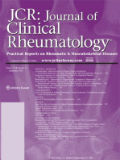 Autores: Garcia, Ana Beatriz Andrêo MD; Dardin, Luciana Paula BSPT; Minali, Paulo Alexandre BSPE; Czapkowsky, Adriano MD; Ajzen, Sergio Aron MD, PhD; Trevisani, Virginia Fernandes Moça MD, PhD
Autores: Garcia, Ana Beatriz Andrêo MD; Dardin, Luciana Paula BSPT; Minali, Paulo Alexandre BSPE; Czapkowsky, Adriano MD; Ajzen, Sergio Aron MD, PhD; Trevisani, Virginia Fernandes Moça MD, PhD
JCR: Journal of Clinical Rheumatology:• Doi: 10.1097/RHU.0000000000000413 • September 2016
Background: Primary Sjögren syndrome is a chronic inflammatory autoimmune disease. The delay in diagnosis allows the establishment of a chronic inflammatory state, which makes primary Sjögren syndrome an interesting model for the study of atherosclerosis.
Objectives: The aim of this study was to evaluate subclinical atherosclerosis in 49 patients with Sjögren syndrome using noninvasive methods.
Methods: We assessed traditional risk factors such as hypertension, diabetes, dyslipidemia, smoking, and family history of atherosclerosis. Patients with prior cardiovascular events and a history of atherosclerosis were excluded. Clinical and laboratory features were recorded, as well as the European League Against Rheumatism Sjögren’s Syndrome Activity Index calculation. The atherosclerosis evaluation was done by carotid intima-media thickness, measured by ultrasonography, and ankle-brachial index (ABI).
Results: Fifteen patients (31%) had at least 1 traditional risk factor, and 65.3% had a European League Against Rheumatism Sjögren’s Syndrome Activity Index score from mild to moderate. Only 2 patients had increased carotid intima-media thickness. However, 59% presented ABI alterations. Multiple correspondence analysis showed a clear correlation between low ABI and the positivity of autoantibodies (antinuclear antibodies, anti-SSA, rheumatoid factor).
Conclusions: The subgroup of patients with positive autoantibodies showed low ABI, which may represent a higher risk of early atherosclerosis and indicate the need for more careful monitoring in this group.


